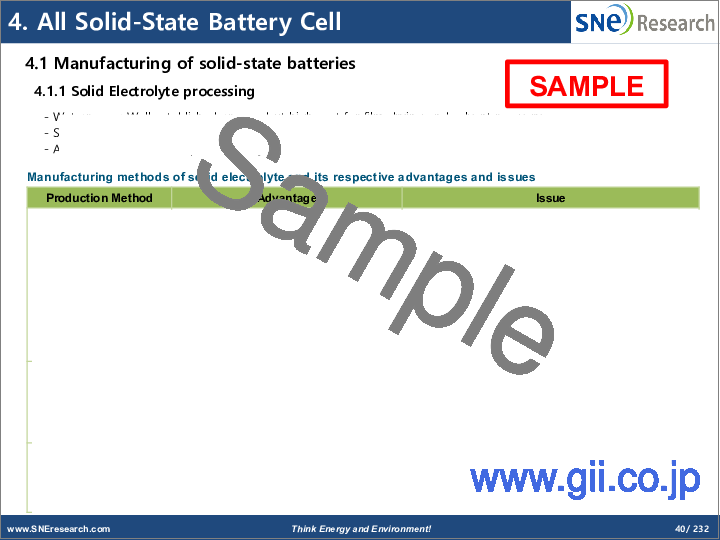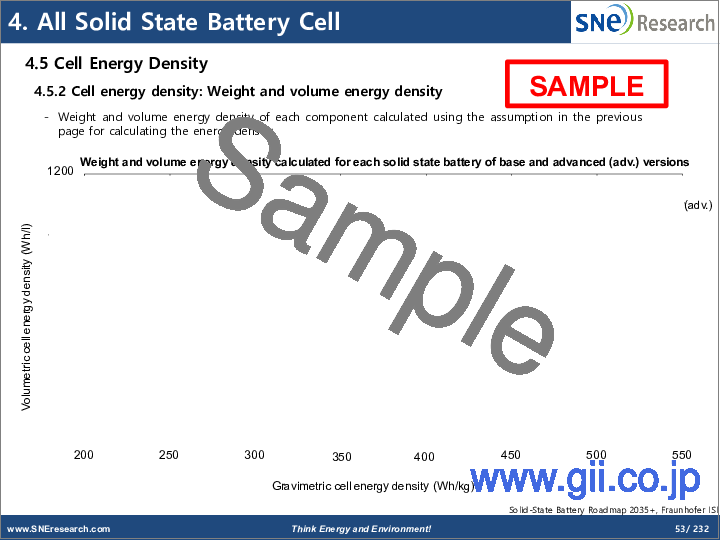|
|
市場調査レポート
商品コード
1212745
現在および将来の全固体電池の製造技術:2023年<2023> The Present and Future of All Solid-State Battery Manufacturing Technology |
||||||
| 現在および将来の全固体電池の製造技術:2023年 |
|
出版日: 2023年01月27日
発行: SNE Research
ページ情報: 英文 232 Pages
納期: お問合せ
|
- 全表示
- 概要
- 目次
現在最も多く使用されているリチウムイオン電池は、新しい電子機器や電気自動車の爆発的な需要に支えられ、継続的な技術開発によって性能が向上してきました。しかし、リチウムイオン電池はエネルギー密度が高さから、火災や爆発の危険性があります。これらのリスクを回避するため、固体電解質を応用した全固体電池が次世代電池技術として注目されています。
世界の全固体電池の市場規模は180%の高成長を記録し、2022年の約2,750万米ドルから、2030年には約400億ドルの巨大市場を形成すると予想されています。
当レポートでは、全固体電池の製造技術を調査し、全固体電池の概要、主要コンポーネントの各種タイプ、特徴、製造工程、課題とソリューション、大手企業の製造技術などをまとめています。
目次
第1章 全固体電池の概要
- 全固体電池(ASB)
- 全固体電池固体電解質
- 全固体技術の動向
- 全固体電池市場の見通し
第2章 固体電解質
- 酸化物系固体電解質
- 酸化物系電解質の性質
- 酸化物系電解質の関連特性
- 酸化物固体電解質のイオン伝導度と用途
- NASICON系
- ガーネット系
- ペロブスカイト系
- 酸化物電解質の主な課題
- 酸化物電解質の具体的な課題と解決策
- 硫化物系固体電解質
- 硫化物系電解質の特徴:長所
- 硫化物系の電解質の特徴:短所
- 硫化物電解質の特徴
- 硫化物系固体電解質のイオン伝導性と用途
- LPS系
- LPS系:結晶構造
- Thio-LISICON系
- LGPS系
- LGPS系:構造とイオン伝導度
- アギロダイト
- 硫化物系の電解質の特定の問題と解決策
- 高分子固体電解質
- 高分子マトリックスのタイプと性質
- 高分子電解質のタイプと長所・短所
- 高分子電解質の特長
- 高分子電解質の課題と解決策
- 固体電解質の適合性
第3章 全固体電池の電極
- カソード
- 全固体電池に適用されるカソード活物質
- カソード活物質の動向
- カソードおよび複合カソード処理
- アノード
- シリコンアノード
- Si/黒鉛アノード
- リチウムアノード
- リチウム金属アノード処理
- アノードなし
- 薄膜またはアノードなしのアプリケーション
- リチウム金属およびシリコンアノード処理
- アノードレスと他のアノードの比較
- リチウム金属アノードとシリコンアノードの製法比較
第4章 全固体電池セル
- 全固体電池の製造
- 固体電解質処理
- セルアセンブリ
- セル仕上げ
- 全固体電池とLIBの製造工程比較
- 全固体電池の材料費
- 全固体電池セルの製造コスト
- 全固体電池用固体電解質のコスト比較
- 全固体電池セルの有望なコンセプト
- 全固体電池セルの製造
- 酸化物系全固体電池
- 硫化物系全固体電池
- ポリマー系全固体電池
- セルエネルギー密度
第5章 全固体電池の製造技術
- ラボ用セル製造
- ラボレベルのセル製造
- パウダープレスセル製造
- 粉末プレスによる三極セルの製造工程
- コインセルの製造工程
- 日本のNEDO:全固体電池ロードマップ
- パウチセルの製造工程:NEDO標準セル
- パウチセルの製造工程:NEDO実証セル
- NEDO大面積ラミネート実証セルの製作
- 第1世代固体デモセルLIB
- 日本NEDO:次世代固体実証セルLIB
- セル製造技術
- 全固体電池のタイプ別の長所と短所
- 固体電解質のタイプに応じた適切な製造方法
- CIP、WIP、HIPの比較
- 固体電解質のタイプに応じた適切な方法
- 電極・電解質層の緻密化工程
- 複合電極およびセパレーターの製造
- ラミネーション&スタッキングプロセス
- スラリー・溶液キャスト法
- 押出工程
- テープキャスティングプロセス
- 電解質注入プロセス
- セル製造工程
- 共通LIB製造工程
- 全固体電池:カソードの製造
- 全固体電池:アノードの製造
- 固体電池: セルの製造
- 固体セル: セルコンディショニング
- 固体セル: セル処理コスト
- 固体セル: プロセス比較
- セル製造の全体の流れ
- 固体電解質セパレータの製造工程の流れ
- 固体電解質セパレータの製造工程詳細
- 固体電解質セパレータの製造工程(複合カソード)
- アノード製造工程の流れ
- アノード製造工程の詳細
- リチウム箔の製造工程
- 複合カソード:主な製造工程の流れ
- 複合カソードの製造工程(詳細)
- 複合カソードの製造工程と設備
- セル組立の主な工程の流れ
- セル組立の主な工程(詳細)
- セル組立:スタック製造工程
- 各製造工程の長所・短所比較
- 酸化物固体電解質応用電池の製造工程
- LIBプロセスによるSSB用カソード・アノードの製造
- LIBプロセスを使用した固体セルの後処理
- セル製法
- 平面プレスとロールプレスの限界
- HIP(Hot Isostatic Pressing)とホットプレスの違い
- 比較:従来の焼結法による固体電解質 vs HIP
- カソード材の湿式製法
- カソード活物質の表面コーティング
- 活物質複合体の形成と球形の成形
第6章 大手企業の製造技術
- TOYOTA
- HONDA
- Nissan
- SES
- Solid Power
- Blue Solution
- QuantumScape
- ProLogium
- Johnson Energy Storage
- TaiyoYuden
Title:
<2023> The Present and Future of All Solid-State Battery Manufacturing Technology
(Subtitle: In-depth Analysis on Manufacturing Technology and R&D Trend of Major Companies)
The performance of lithium-ion battery (LIB), most widely used today, has been improved through continuous technology development propped up with an explosive demand in new electronic devices and electric vehicles. Particularly, the energy density has been dramatically increased from 80Wh/kg in the nascent stage to 300Wh/kg of these days. However, a high energy density implies a possible risk of fire or explosion. Lithium-ion battery may have an explosion triggered bWy internal overheating, secondary heat release from outside, and electrical defect caused by mechanical damage, excessive discharging, and overcharging.
To prevent such risk, all solid-state battery to which solid electrolyte is applied has become regarded as a next-generation battery technology. Megatrends in all solid-state battery can be summarized as follows: excellent safety; high energy density; high power output; wide range of workable temperature; and simple battery structure. Thanks to these properties, all solid-state battery can be free from explosion risks. In addition, solid electrolyte has a better ionic conductivity than liquid electrolyte when the temperature is below 0°C or between 60~100°C.
According to market forecast by SNE Research, the global all solid-state battery market posted a high growth of 180%, reaching approx. 27.5 million dollar in 2022 and is expected to form a huge market worth of approx. 40 billion dollars in 2030. The Korean government also sees the next decade to be a turning point for countries to determine their positions in the global LIB market. Along with the announcement of <2030 K-Battery Development Strategy>, the government has been providing support for technology development with an aim to achieve the commercialization of all solid-state battery in 2027.
To brace for a rapid paradigm shift from lithium-ion battery to all solid-state battery, it is necessary to take an preemptive measure to carry out deep-dive research on key ASB materials and development of mass production technology. Meanwhile, the expected time frame for ASB commercialization has been postponed to 2030 because companies have not exerted sufficient effort to develop related materials and the production technology has not been fully established yet. Given all these circumstances, this report aims to present the cell configuration of all solid-state battery of which possibility in commercialization is highest. We identify the issues related to materials and manufacturing technology and then propose feasible solutions to those issues.
In addition, we analyze announcements and patent applications by major companies regarding the development of all solid-state battery to learn more about their manufacturing technology. Based on a deep-dive analysis on the manufacturing technology and processes, we identify their advantages/disadvantages and try to find suitable manufacturing processes for all solid-state battery.
Strong Points:
- 1. All solid-state battery technology trend and market outlook
- 2. Solid electrolyte-related issues and solutions
- 3. Cell configuration and issues to consider in case of apply solid electrolyte to battery
- 4. Comparison of all-solid-state battery cell manufacturing technology and process
- 5. Trend of manufacturing technology by major companies such as Toyota, SES, Solid Power
Table of Contents
1. All-Solid-State Battery Overview
- 1.1. All-Solid-State Battery (ASB)
- 1.1.1. Limitations in LIB
- 1.1.2. Necessity for All-solid-state Battery Development
- 1.1.3. Application of All-solid-state Battery
- 1.1.4. All-solid-state Battery Market Outlook
- 1.1.5. All-solid-state Battery Patent Application Status by Country
- 1.1.6. All-solid-state Battery Paper Publication Status by Country
- 1.2. All-Solid-State Battery Solid Electrolyte
- 1.2.1. Solid Electrolyte Type and Composition
- 1.2.2. Solid Electrolyte Major Players by Type
- 1.2.3. Solid Electrolyte Major Players' Trend
- 1.2.4. Solid Electrolyte Patent Application Status by Type
- 1.2.5. Inorganic Solid Electrolyte Patent Application Status by Type
- 1.3. All-Solid-State Technology Trend
- 1.3.1. OEMs' R&D and Response Status
- 1.3.2. Material Parts Developers' R&D and Response Status
- 1.3.3. Battery Makers' R&D and Response Status
- 1.3.4. Battery Makers (OEMs) Response Status by Solid Electrolyte
- 1.3.5. Expected ASB Production Timeline and Energy Density by Battery Makers
- 1.4. All-Solid-State Battery Market Outlook
- 1.4.1. Market Outlook by Research Firm
- 1.4.2. Market Outlook by Electrolyte Type
- 1.4.3. Market Expansion Stage
- 1.4.4. Solid Electrolyte Market by Type
- 1.4.5. Solid Electrolyte Market Share Outlook by Type
2. Solid Electrolyte
- 2.1. Oxide-based Solid Electrolyte
- 2.1.1. Properties of Oxide-based Electrolyte
- 2.1.2. Related Properties of Oxide-based Electrolyte
- 2.1.3. Ionic Conductivity and Applications of Oxide Solid Electrolyte by Type
- 2.1.4. NASICON-based
- 2.1.5. Garnet-based
- 2.1.6. Perovskite-based
- 2.1.7. Major Issues of Oxide Electrolyte
- 2.1.8. Specific Issues and Solutions of Oxide Electrolyte
- 2.2. Sulfide-based Solid Electrolyte
- 2.2.1. Features of Sulfide-based Electrolyte: Advantages
- 2.2.2. Features of Sulfide-based Electrolyte: Disadvantages
- 2.2.3. Features of Sulfide-based Electrolyte
- 2.2.4. Ionic Conductivity and Application of Sulfide-based Solid Electrolyte by Type
- 2.2.5. LPS-based
- 2.2.6. LPS-based: crystal structure
- 2.2.7. Thio-LISICON based
- 2.2.8. LGPS-based
- 2.2.9. LGPS-based : Structure and ionic conductivity
- 2.2.10. Agyrodites
- 2.2.11. Specific Issues and Solutions for Sulfide-base Electrolyte
- 2.3. Polymer Solid Electrolyte
- 2.3.1. Types and Properties of Polymer Matrix
- 2.3.2. Types and Benefit/Shortcomings of Polymer Electrolyte
- 2.3.3. Features of Polymer Electrolyte
- 2.3.4. Issues and Solutions of Polymer Electrolyte
- 2.4. Compatibility of Solid Electrolyte
- 2.4.1. Issues with ASB Cell to Consider
- 2.4.2. Cathode-Electrolyte Compatibility Issue
- 2.4.3. Anode-Electrolyte Compatibility Issue
3. All-Solid-State Battery Electrodes
- 3.1. Cathode
- 3.1.1. Cathode Active Material Applied to All-Solid-State Battery
- 3.1.2. Trend in Cathode Active Material
- 3.1.3. Cathode and Compound Cathode processing
- 3.2. Anode
- 3.2.1. Silicon Anode
- 3.2.2. Si/Graphite Anode
- 3.2.3. Lithium Anode
- 3.2.4. Lithium Metal Anode processing
- 3.2.5. Anodeless
- 3.2.6. Thin film or anode-less application
- 3.2.7. Lithium Metal and Silicon Anode processing
- 3.2.8. Comparison of Anode-less and Other Anodes
- 3.2.9. Comparison of production method for lithium metal anode and silicon anode
4. All Solid State Battery Cell
- 4.1. Manufacturing of solid state batteries
- 4.1.1. Solid Electrolyte processing
- 4.1.2. Cell Assembly
- 4.1.3. Cell Finishing
- 4.1.4. Comparison of manufacturing process of Solid state batteries and LIBs (1)
- 4.1.5. Comparison of manufacturing process of Solid state batteries and LIBs (2)
- 4.1.6. Material cost of solid state batteries
- 4.1.7. Manufacturing cost of solid state battery cells
- 4.1.8. Cost Comparison of Solid Electrolytes for Solid State Batteries
- 4.1.9. Promising Concept of Solid State Battery Cell
- 4.1.10. Manufacturing of solid state battery cells
- 4.2. Oxide-based Solid State Batteries
- 4.2.1. Most promising cell configuration
- 4.2.2. Considerations in terms of cell structure
- 4.2.3. Considerations for Battery Production
- 4.2.4. Key Performance Indicators
- 4.2.5. Changes in Cell Concept
- 4.3. Sulfide-based Solid State Batteries
- 4.3.1. Cell Configuration
- 4.3.2. Considerations in terms of cell structure
- 4.3.3. Considerations for Battery Production
- 4.3.4. Key Performance Indicators
- 4.3.5. Structure (Silicon anode applied)
- 4.3.6. Considerations in terms of cell structure when applying Si/C composite anode
- 4.3.7. Considerations for cell production when applying Si/C composite anode
- 4.3.8. Key performance indicators when applying Si/C composite anode
- 4.4. Polymer-based Solid State Batteries
- 4.4.1. Configuration of polymer solid state batteries
- 4.4.2. Considerations in terms of cell structure
- 4.4.3. Considerations for cell production
- 4.4.4. Key performance indicators
- 4.5. Cell Energy Density
- 4.5.1. Assumptions for Base and Advanced Version of Cell Materials
- 4.5.2. Weight and volume energy density
- 4.5.3. Expected scenario and Roadmap
5. Manufacturing Technology of All Solid State Batteries
- 5.1. Laboratory Cell Production
- 5.1.1. Laboratory Level Cell Production
- 5.1.2. Powder pressing Cell Production
- 5.1.3. Three-electrode cell production process by using powder pressing
- 5.1.4. Coin Cell Production Process
- 5.1.5. All solid state battery roadmap of Japan NEDO
- 5.1.6. Pouch Cell Production Process: NEDO Standard Cell
- 5.1.7. Pouch Cell Production Process : NEDO demonstration cell
- 5.1.8. Production of NEDO Large Area Laminated Demonstration Cell
- 5.1.9. First Generation Solid State Demonstration Cell LIB
- 5.1.10. Japan NEDO : Next Generation Solid State Demonstration Cell LIB
- 5.2. Cell Manufacturing Technology
- 5.2.1. Advantages and disadvantages as per solid state battery type
- 5.2.2. Suitable manufacturing method according to solid electrolyte type
- 5.2.3. Comparison of CIP, WIP, HIP
- 5.2.4. Suitable methods according to solid electrolyte type
- 5.2.5. Densification process of electrode/electrolyte layer
- 5.2.6. Production of composite electrodes and separators
- 5.2.7. Lamination & Stacking Process
- 5.2.8. Slurry/solution casting process
- 5.2.9. Extrusion process
- 5.2.10. Tape casting process
- 5.2.11. Electrolyte infusion process
- 5.3. Cell Manufacturing Process
- 5.3.1. Common LIB production process
- 5.3.2. Solid state cells : Production of cathode
- 5.3.3. Solid state cells : Production of anode
- 5.3.4. Solid state cells : Production of cell
- 5.3.5. Solid state cells : Cell conditioning
- 5.3.6. Solid state cells : Cell processing cost
- 5.3.7. Solid state cells : Process comparison
- 5.3.8. Entire Flow of Cell Production
- 5.3.9. Solid Electrolyte Separator Manufacturing Process Flow
- 5.3.10. Details of Solid Electrolyte Separator Manufacturing Process
- 5.3.11. Manufacturing process of solid electrolyte separator (on composite cathode)
- 5.3.12. Anode production process flow
- 5.3.13. Details of anode production process
- 5.3.14. Lithium foil manufacturing process
- 5.3.15. Composite Cathode : Main production process flow
- 5.3.16. Composite cathode production process (in detail)
- 5.3.17. Composite cathode production process and equipement
- 5.3.18. Main process flow of cell assembly
- 5.3.19. Main process of cell assembly (in detail)
- 5.3.20. Cell assembly : Stack production process
- 5.3.21. Comparison of advantages / disadvantages of each manufacturing process
- 5.3.22. Production Process of Oxide Solid Electrolyte-Applied Cells
- 5.3.23. Manufacture of cathode and anode for SSB by using LIB process
- 5.3.24. Post-Process of Solid State Cells by using LIB Process
- 5.4. Cell manufacturing method
- 5.4.1. Limits of plane press and roll press
- 5.4.2. Difference of HIP(Hot Isostatic Pressing) and Hot Pressing
- 5.4.3. Comparison: solid electrolyte treated by conventional sintering method vs HIP
- 5.4.4. Wet manufacturing method of cathode material
- 5.4.5. Coating the surface of cathode active material
- 5.4.6. Forming active material composite and shaping spherical form
6. Manufacturing Technology in Major Companies
- 6.1. TOYOTA
- 6.1.1. Identifying cause of performance degradation of Toyota's solid state battery
- 6.1.2. Performance degradation in long cycle
- 6.1.3. Toyota's counter-measures for the performance degradation
- 6.1.4. Counter-measures and Solutions
- 6.1.5. Toyota's Step of Applying Solid State Batteries
- 6.1.6. Toyota's Solid State Battery Manufacturing: Pressing
- 6.1.7. Toyota's Solid State Battery Manufacturing : Sublimable filler
- 6.1.8. Toyota's Solid State Battery Manufacturing : HIP
- 6.1.9. Toyota's Solid State Battery Manufacturing : Resin packaging
- 6.2. HONDA
- 6.2.1. Honda's Direction of Solid State Cell Manufacturing
- 6.2.2. Honda's Direction of Solid State Cell Manufacturing
- 6.2.3. Honda's Solid State Battery Manufacturing Process: Mixing
- 6.2.4. Honda's Solid State Battery Manufacturing Process: Electrode Coating
- 6.2.5. Solid State Battery Manufacturing Process : Bonding roll pressing
- 6.2.6. Solid State Battery Manufacturing Process : Electrode slitting
- 6.2.7. Solid State Battery Manufacturing Process : Bonding roll pressing
- 6.2.8. Solid State Battery Manufacturing Process : Stacking
- 6.2.9. Solid State Battery Manufacturing Process : Tab welding, assembly, sealing
- 6.2.10. Solid State Battery Manufacturing Process : Aging, Inspection
- 6.3. Nissan
- 6.3.1. Direction of Solid State Cell Manufacturing
- 6.3.2. Overview of Solid State Battery Manufacturing Process
- 6.3.3. Solid State Battery Manufacturing Process
- 6.4. SES
- 6.4.1. SES Overall cell structure
- 6.4.2. Cell Performance
- 6.4.3. SES cell P/P line major processes
- 6.5. Solid Power
- 6.5.1. Solid state battery structure and development line-up
- 6.5.2. Solid state cell manufacturing process
- 6.5.3. Roadmap of Si Anode Solid State Batteries
- 6.5.4. Roadmap of Li Anode Solid State Batteries
- 6.5.5. Solid State Battery Production Roadmap
- 6.6. Blue Solution
- 6.6.1. LMP® Solid state battery structure
- 6.6.2. Manufacturing process of Blue Solution
- 6.6.3. Solid state battery roadmap
- 6.7. QuantumScape
- 6.7.1. Cell performance of solid state batteries
- 6.7.2. Solide state cell manufacturing process and cell characteristics
- 6.7.3. Solide state battery roadmap
- 6.8. ProLogium
- 6.8.1. Solid state battery cell structure
- 6.8.2. Solid state battery structure and performance
- 6.8.3. Solid state battery production line
- 6.8.4. Solid state battery production process
- 6.9. Johnson Energy Storage
- 6.9.1. Cell information and related characteristics
- 6.9.2. Slurry coating process
- 6.9.3. Co-extrusion process
- 6.10. TaiyoYuden
- 6.10.1. MLCC Type solid state cell structure
- 6.10.2. MLCC Type solid state cell production process




